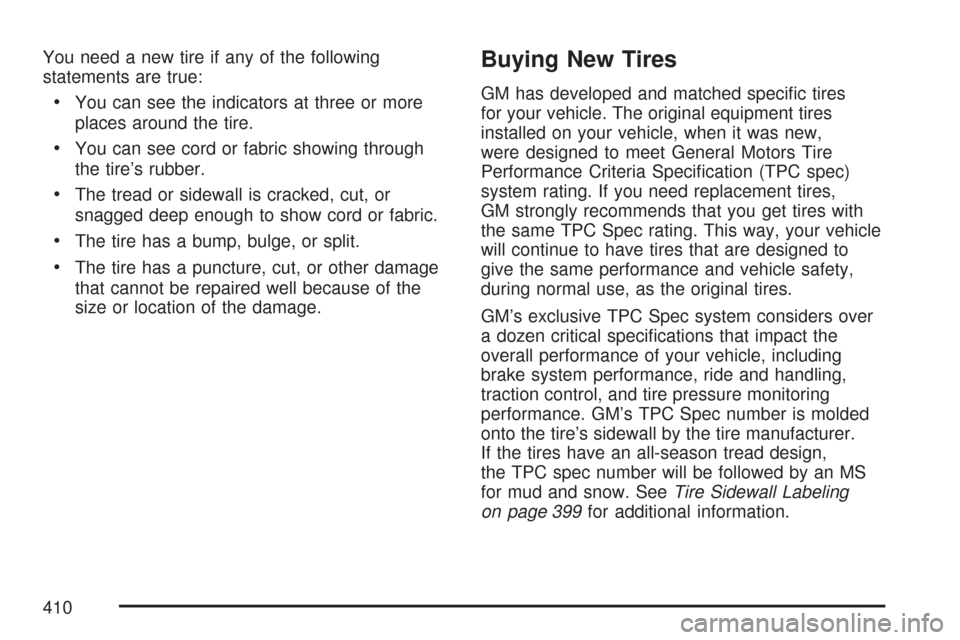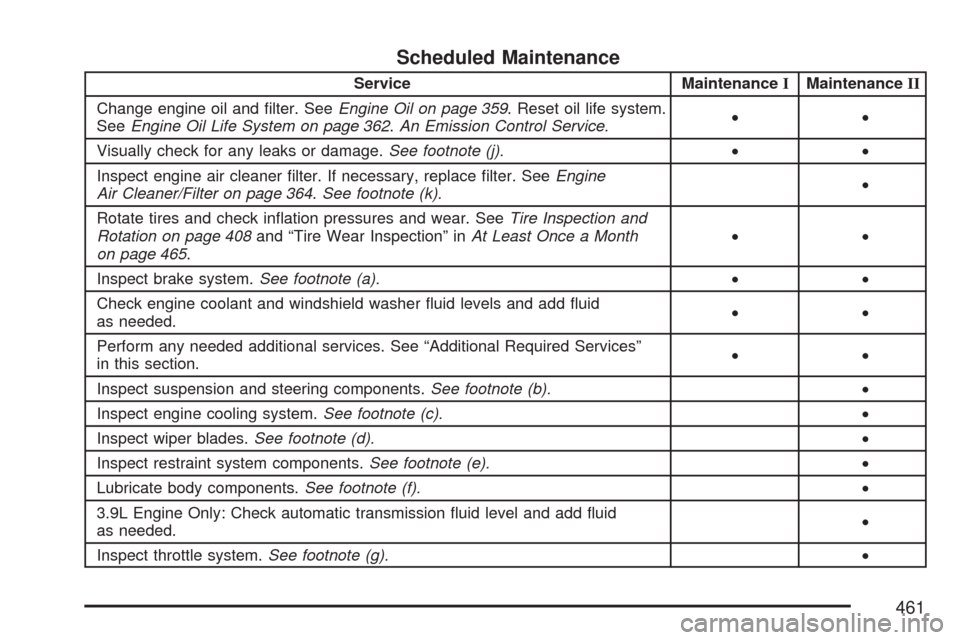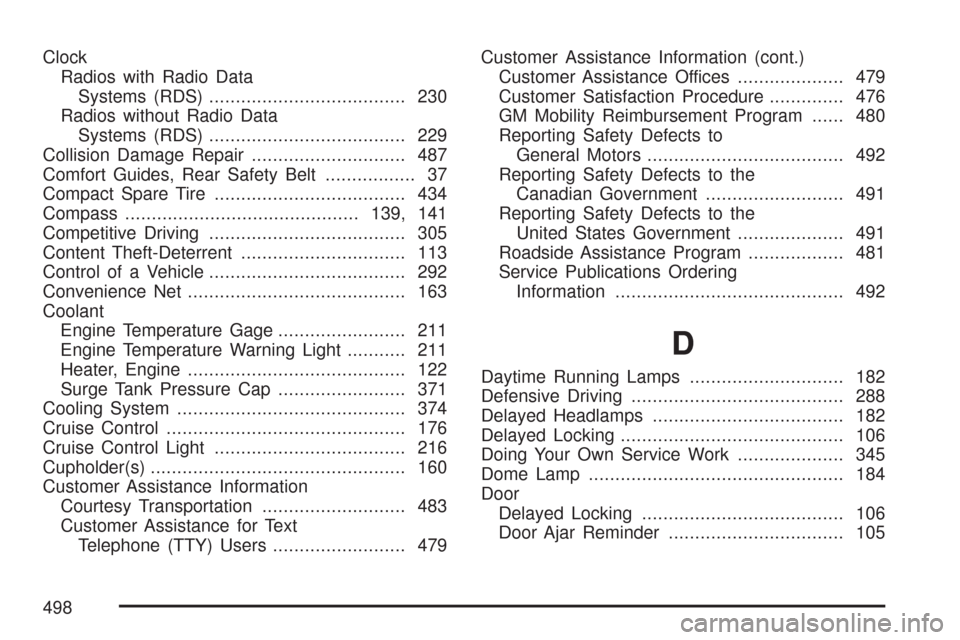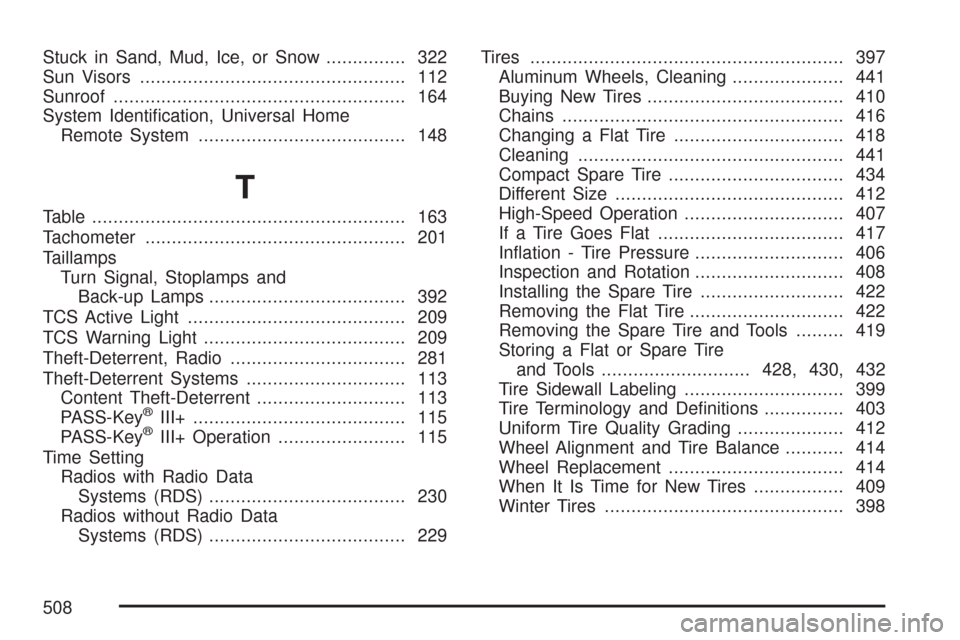2007 CHEVROLET MALIBU MAXX tire pressure
[x] Cancel search: tire pressurePage 410 of 510

You need a new tire if any of the following
statements are true:
You can see the indicators at three or more
places around the tire.
You can see cord or fabric showing through
the tire’s rubber.
The tread or sidewall is cracked, cut, or
snagged deep enough to show cord or fabric.
The tire has a bump, bulge, or split.
The tire has a puncture, cut, or other damage
that cannot be repaired well because of the
size or location of the damage.
Buying New Tires
GM has developed and matched speci�c tires
for your vehicle. The original equipment tires
installed on your vehicle, when it was new,
were designed to meet General Motors Tire
Performance Criteria Speci�cation (TPC spec)
system rating. If you need replacement tires,
GM strongly recommends that you get tires with
the same TPC Spec rating. This way, your vehicle
will continue to have tires that are designed to
give the same performance and vehicle safety,
during normal use, as the original tires.
GM’s exclusive TPC Spec system considers over
a dozen critical speci�cations that impact the
overall performance of your vehicle, including
brake system performance, ride and handling,
traction control, and tire pressure monitoring
performance. GM’s TPC Spec number is molded
onto the tire’s sidewall by the tire manufacturer.
If the tires have an all-season tread design,
the TPC spec number will be followed by an MS
for mud and snow. SeeTire Sidewall Labeling
on page 399for additional information.
410
Page 434 of 510

Storing the Compact Spare Tire
and Tools
The compact spare tire is for temporary use only.
Store the compact spare tire and tools as shown in
the following diagram.
A. Cover
B. Retainer
C. Spare Tire
D. Wing Nut
E. BracketF. Jack, Wheel
Wrench and Bolt
Extension
G. BoltThe compact spare is for temporary use only.
Replace the compact spare tire with a full-size tire
as soon as you can. SeeCompact Spare Tire on
page 434.
Compact Spare Tire
Although the compact spare tire was fully in�ated
when the vehicle was new, it can lose air after a
time. Check the in�ation pressure regularly.
It should be 60 psi (420 kPa).
After installing the compact spare on the vehicle,
stop as soon as possible and make sure the spare
tire is correctly in�ated. The compact spare is made
to perform well at speeds up to 65 mph (105 km/h)
for distances up to 3,000 miles (5 000 km), so you
can �nish your trip and have the full-size tire
repaired or replaced at your convenience. Of
course, it is best to replace the spare with a full-size
tire as soon as possible. The spare tire will last
longer and be in good shape in case it is needed
again.
Notice:When the compact spare is installed,
do not take your vehicle through an automatic
car wash with guide rails. The compact spare
can get caught on the rails. That can damage
the tire and wheel, and maybe other parts of
your vehicle.
434
Page 461 of 510

Scheduled Maintenance
Service MaintenanceIMaintenanceII
Change engine oil and �lter. SeeEngine Oil on page 359. Reset oil life system.
SeeEngine Oil Life System on page 362.An Emission Control Service.••
Visually check for any leaks or damage.See footnote (j).••
Inspect engine air cleaner �lter. If necessary, replace �lter. SeeEngine
Air Cleaner/Filter on page 364.See footnote (k).•
Rotate tires and check in�ation pressures and wear. SeeTire Inspection and
Rotation on page 408and “Tire Wear Inspection” inAt Least Once a Month
on page 465.••
Inspect brake system.See footnote (a).••
Check engine coolant and windshield washer �uid levels and add �uid
as needed.••
Perform any needed additional services. See “Additional Required Services”
in this section.••
Inspect suspension and steering components.See footnote (b).•
Inspect engine cooling system.See footnote (c).•
Inspect wiper blades.See footnote (d).•
Inspect restraint system components.See footnote (e).•
Lubricate body components.See footnote (f).•
3.9L Engine Only: Check automatic transmission �uid level and add �uid
as needed.•
Inspect throttle system.See footnote (g).•
461
Page 465 of 510

Engine Oil Level Check
Check the engine oil level and add the proper
oil if necessary. SeeEngine Oil on page 359for
further details.
Notice:It is important to check the engine
oil regularly and keep it at the proper
level. Failure to keep the engine oil at the
proper level can cause damage to the engine
not covered by your warranty.
Engine Coolant Level Check
Check the engine coolant level and add
DEX-COOL®coolant mixture if necessary. See
Engine Coolant on page 368for further details.
Windshield Washer Fluid Level Check
Check the windshield washer �uid level in
the windshield washer �uid reservoir and add
the proper �uid if necessary.
At Least Once a Month
Tire In�ation Check
Inspect your vehicle’s tires and make sure they are
in�ated to the correct pressures. Do not forget to
check the spare tire. SeeIn�ation - Tire Pressure
on page 406. Check to make sure the spare tire
is stored securely. SeeChanging a Flat Tire
on page 418.
Tire Wear Inspection
Tire rotation may be required for high mileage
highway drivers prior to the Engine Oil Life
System service noti�cation. Check the tires for
wear and, if necessary, rotate the tires. See
Tire Inspection and Rotation on page 408.
465
Page 498 of 510

Clock
Radios with Radio Data
Systems (RDS)..................................... 230
Radios without Radio Data
Systems (RDS)..................................... 229
Collision Damage Repair............................. 487
Comfort Guides, Rear Safety Belt................. 37
Compact Spare Tire.................................... 434
Compass............................................139, 141
Competitive Driving..................................... 305
Content Theft-Deterrent............................... 113
Control of a Vehicle..................................... 292
Convenience Net......................................... 163
Coolant
Engine Temperature Gage........................ 211
Engine Temperature Warning Light........... 211
Heater, Engine......................................... 122
Surge Tank Pressure Cap........................ 371
Cooling System........................................... 374
Cruise Control............................................. 176
Cruise Control Light.................................... 216
Cupholder(s)................................................ 160
Customer Assistance Information
Courtesy Transportation........................... 483
Customer Assistance for Text
Telephone (TTY) Users......................... 479Customer Assistance Information (cont.)
Customer Assistance Offices.................... 479
Customer Satisfaction Procedure.............. 476
GM Mobility Reimbursement Program...... 480
Reporting Safety Defects to
General Motors..................................... 492
Reporting Safety Defects to the
Canadian Government.......................... 491
Reporting Safety Defects to the
United States Government.................... 491
Roadside Assistance Program.................. 481
Service Publications Ordering
Information........................................... 492
D
Daytime Running Lamps............................. 182
Defensive Driving........................................ 288
Delayed Headlamps.................................... 182
Delayed Locking.......................................... 106
Doing Your Own Service Work.................... 345
Dome Lamp................................................ 184
Door
Delayed Locking...................................... 106
Door Ajar Reminder................................. 105
498
Page 501 of 510

G
Gage
Engine Coolant Temperature.................... 211
Fuel......................................................... 217
Speedometer........................................... 200
Tachometer.............................................. 201
Garage Door Opener................................... 149
Gasoline
Octane..................................................... 346
Speci�cations........................................... 347
Glove Box................................................... 160
GM Mobility Reimbursement Program.......... 480
H
Hazard Warning Flashers............................ 170
Head Restraints............................................ 13
Headlamp Wiring......................................... 445
Headlamps
Bulb Replacement.................................... 389
Daytime Running Lamps.......................... 182
Delayed................................................... 182
Exterior Lamps......................................... 179
Flash-to-Pass........................................... 173Headlamps (cont.)
Halogen Bulbs......................................... 389
Headlamps, Front Turn Signal, and
Parking Lamps..................................... 390
High/Low Beam Changer......................... 172
On Reminder........................................... 181
Headlamps Off in Park (P).......................... 181
Heated Seats................................................ 10
Heater................................................188, 192
Highbeam On Light..................................... 216
High-Speed Operation, Tires........................ 407
Highway Hypnosis....................................... 314
Hill and Mountain Roads............................. 315
Hood
Checking Things Under............................ 352
Release................................................... 352
Horn............................................................ 170
How to Use This Manual................................ 3
How to Wear Safety Belts Properly............... 25
I
Ignition Positions......................................... 118
Infants and Young Children, Restraints.......... 45
In�ation - Tire Pressure............................... 406
501
Page 502 of 510

Instrument Panel
Overview.................................................. 168
Instrument Panel (I/P)
Brightness................................................ 184
Cluster..................................................... 198
J
Jump Starting.............................................. 385
K
Keyless Entry System................................... 96
Keys............................................................. 95
L
Labeling, Tire Sidewall................................. 399
Lamps
Cargo...................................................... 186
Dome....................................................... 184
Front Reading.......................................... 185
Rear Reading.......................................... 185
Trunk....................................................... 185LATCH System
Child Restraints......................................... 56
License Plate Lamps................................... 393
Lift Seat, Power............................................ 16
Liftgate
Carbon Monoxide..................................... 110
Light
Airbag Readiness..................................... 202
Anti-Lock Brake System Warning............. 208
Brake System Warning............................. 206
Charging System..................................... 206
Cruise Control.......................................... 216
Engine Coolant Temperature Warning....... 211
Enhanced Traction System (ETS)
Active Light.......................................... 210
Enhanced Traction System (ETS)
Warning Light....................................... 210
Highbeam On.......................................... 216
Malfunction Indicator................................ 212
Oil Pressure............................................. 215
Passenger Airbag Status Indicator............ 203
Passenger Safety Belt Reminder.............. 202
Safety Belt Reminder............................... 201
Security................................................... 216
502
Page 508 of 510

Stuck in Sand, Mud, Ice, or Snow............... 322
Sun Visors.................................................. 112
Sunroof....................................................... 164
System Identi�cation, Universal Home
Remote System....................................... 148
T
Table........................................................... 163
Tachometer................................................. 201
Taillamps
Turn Signal, Stoplamps and
Back-up Lamps..................................... 392
TCS Active Light......................................... 209
TCS Warning Light...................................... 209
Theft-Deterrent, Radio................................. 281
Theft-Deterrent Systems.............................. 113
Content Theft-Deterrent............................ 113
PASS-Key
®III+........................................ 115
PASS-Key®III+ Operation........................ 115
Time Setting
Radios with Radio Data
Systems (RDS)..................................... 230
Radios without Radio Data
Systems (RDS)..................................... 229Tires........................................................... 397
Aluminum Wheels, Cleaning..................... 441
Buying New Tires..................................... 410
Chains..................................................... 416
Changing a Flat Tire................................ 418
Cleaning.................................................. 441
Compact Spare Tire................................. 434
Different Size........................................... 412
High-Speed Operation.............................. 407
If a Tire Goes Flat................................... 417
In�ation - Tire Pressure............................ 406
Inspection and Rotation............................ 408
Installing the Spare Tire........................... 422
Removing the Flat Tire............................. 422
Removing the Spare Tire and Tools......... 419
Storing a Flat or Spare Tire
and Tools............................428, 430, 432
Tire Sidewall Labeling.............................. 399
Tire Terminology and De�nitions............... 403
Uniform Tire Quality Grading.................... 412
Wheel Alignment and Tire Balance........... 414
Wheel Replacement................................. 414
When It Is Time for New Tires................. 409
Winter Tires............................................. 398
508